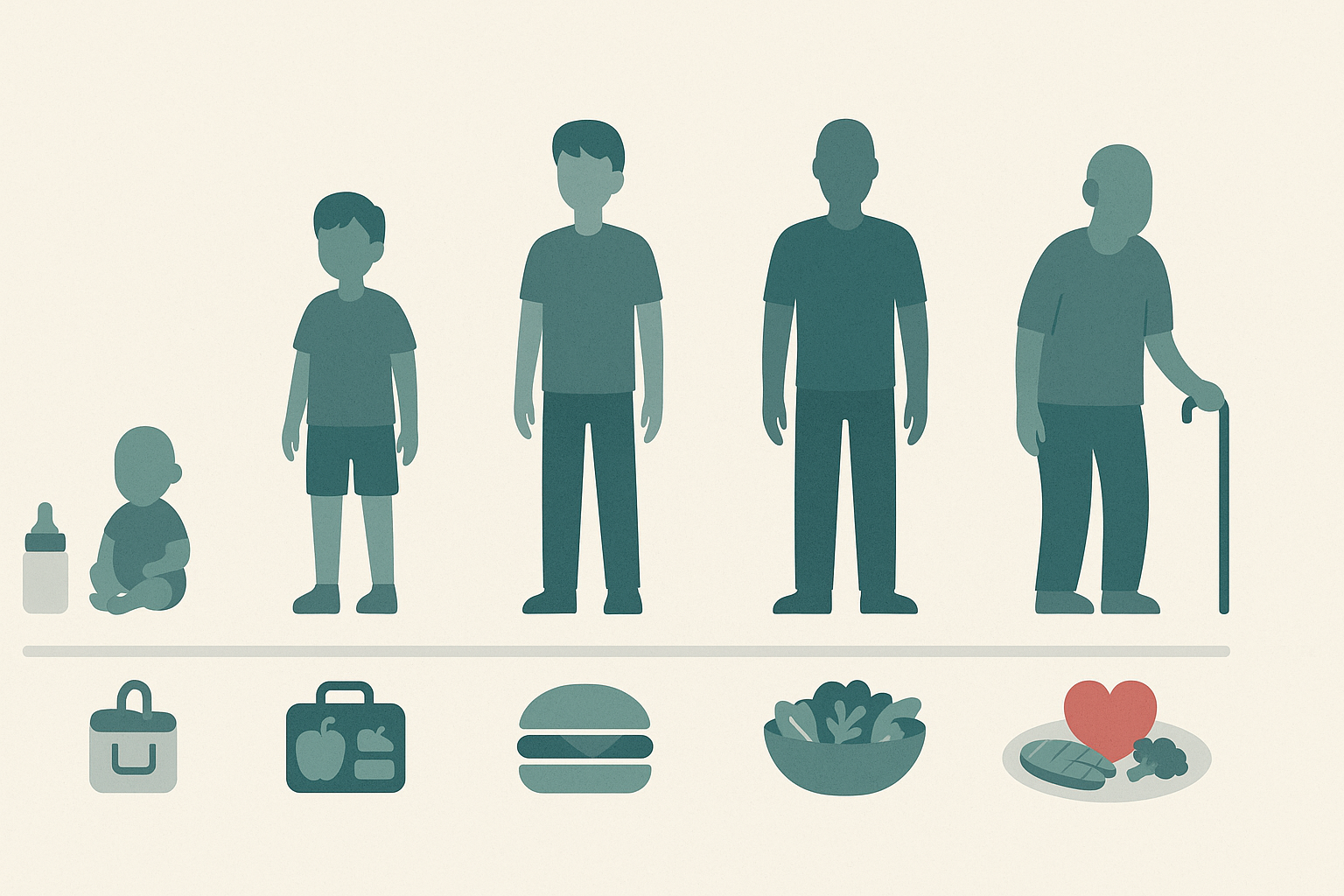Pregnancy is a profound physiological journey marked by complex metabolic changes, hormonal fluctuations, and an evolving need for nutritional adequacy. Understanding how to meet the body’s shifting demands is central to supporting a healthy pregnancy. Among the most practical tools for expecting mothers is the pregnancy calorie calculator. Designed to help track daily caloric intake tailored to gestational needs, this digital tool can guide nutritional choices and promote appropriate weight gain. However, its utility depends on accurate input, responsible interpretation, and expert-informed guidance.
You may also like: 4 Ways to Have a Healthy Diet: Expert Tips Backed by Science for Better Nutrition and Long-Term Wellness
In this comprehensive guide, we explore how to use a calorie calculator during pregnancy safely and effectively. We also delve into the broader context of maternal nutrition, the role of sodium and salt in pregnancy health, and science-backed strategies for managing weight and blood pressure throughout each trimester. Whether you’re a first-time parent or navigating a subsequent pregnancy, this article offers a medically grounded, reader-friendly path to understanding and optimizing your diet.

Understanding Caloric Needs in Pregnancy
Caloric needs during pregnancy evolve with each trimester. In the first trimester, many women may not need significantly more calories than they consumed pre-pregnancy. However, by the second and third trimesters, caloric intake must increase to support fetal growth, placenta development, and changes in maternal tissue. A pregnancy calorie calculator considers these stages and factors in pre-pregnancy weight, height, age, activity level, and current trimester to generate a personalized caloric target.
It’s crucial to understand that caloric needs aren’t about eating for two—a common but misleading phrase. Instead, the focus should be on consuming nutrient-dense calories that support both maternal health and fetal development. For instance, in the second trimester, an increase of about 340 calories per day may suffice, while the third trimester may demand an additional 450 calories. Using a calorie calculator during pregnancy helps quantify these adjustments, translating abstract nutritional guidelines into actionable goals.
While a calculator is a helpful baseline, it is essential to cross-reference its recommendations with guidance from an OB-GYN or registered dietitian. Individual metabolic rates, pregnancy complications, and preexisting health conditions may require nuanced nutritional planning. Therefore, the calculator is a tool, not a diagnosis or a substitute for personalized medical advice.
Choosing the Right Pregnancy Calorie Calculator
With dozens of calorie calculators available online, not all are created equal. Reliable tools use algorithms grounded in clinical nutrition standards, such as those established by the Institute of Medicine (IOM) or the American College of Obstetricians and Gynecologists (ACOG). A trustworthy pregnancy calorie calculator will prompt you for essential data: pre-pregnancy body mass index (BMI), gestational week, daily activity level, and any underlying health conditions.
The best calculators also offer breakdowns by macronutrient categories, helping users visualize how calories should be distributed among proteins, carbohydrates, and fats. This macronutrient awareness supports balanced eating and prevents over-reliance on calorie-dense but nutritionally poor foods. Moreover, some advanced tools integrate weekly weight tracking, helping you compare actual weight gain against medically recommended benchmarks.
Mobile apps that sync with fitness trackers can enhance accuracy by accounting for physical activity throughout the day. However, privacy policies and data storage practices should be reviewed to ensure your health information is securely protected. While using any calorie calculator during pregnancy, consider it a supplement to clinical care rather than a comprehensive nutritional authority.

Healthy Weight Gain: Recommendations by Trimester
Weight gain during pregnancy varies by individual but follows general patterns endorsed by healthcare organizations. The Institute of Medicine outlines recommendations based on pre-pregnancy BMI. For women with a normal BMI (18.5-24.9), the advised gain is 25 to 35 pounds. Those underweight before pregnancy may need to gain more, while those classified as overweight or obese may require a more conservative approach.
In the first trimester, weight gain is often minimal, typically ranging from one to five pounds. During the second trimester, an average gain of one pound per week is common, increasing slightly in the third trimester. A pregnancy calorie calculator assists in maintaining this balance by guiding daily caloric adjustments in real-time. This minimizes the risk of excessive or inadequate weight gain, both of which are linked to pregnancy complications such as gestational diabetes, hypertension, and preterm delivery.
Understanding your body’s cues—hunger, fullness, fatigue, and cravings—in tandem with calculator data provides a holistic approach to pregnancy nutrition. Moreover, regular weigh-ins at prenatal appointments can help cross-validate your self-monitoring efforts. If there are discrepancies, your healthcare provider can adjust your plan accordingly.
Sodium and Salt: Navigating the Risks in Pregnancy
Sodium, a vital electrolyte, plays a role in fluid balance, nerve function, and muscle contraction. However, excess sodium is a well-established risk factor for elevated blood pressure, especially during pregnancy when blood volume naturally increases. Many women are advised to follow a low sodium diet blood pressure strategy to mitigate risks such as preeclampsia, a serious condition marked by high blood pressure and organ dysfunction.
One common recommendation from healthcare providers is telling patients to reduce salt intake to maintain optimal cardiovascular health. Although sodium is essential in small amounts, consuming more than the sodium DV (Daily Value), which is 2,300 milligrams for healthy adults, can raise concerns. A low na diet emphasizes fresh produce, lean proteins, whole grains, and reduced consumption of processed foods, which are often hidden sources of sodium.
Understanding food labels becomes crucial when managing sodium intake. Knowing how much sodium per meal is appropriate helps distribute intake evenly throughout the day. Ideally, meals should contain no more than 500-600 milligrams of sodium, keeping room for minor additions across snacks and beverages. When a patient learns what 50 milligrams of salt looks like in real foods, they become empowered to make informed dietary choices.

Salt and Blood Pressure: What Every Pregnant Woman Should Know
There is a strong correlation between salt and blood pressure, especially in populations with salt sensitivity or existing hypertension. In pregnancy, this correlation is amplified due to the cardiovascular demands placed on the maternal body. As blood volume expands and hormonal changes increase fluid retention, dietary sodium can exacerbate fluctuations in blood pressure. For women already diagnosed with chronic hypertension or gestational hypertension, dietary salt management is non-negotiable.
Research supports the link between high sodium intake and pregnancy-related complications, including preeclampsia, premature labor, and fetal growth restriction. Reducing sodium is one of the most immediate interventions available to expectant mothers, often more impactful than medication in early stages. The phrase does sodium raise blood pressure is no longer just a question—it’s a clinical reality validated by numerous studies.
Health professionals advocate for culinary strategies like seasoning with herbs instead of salt, choosing unsalted versions of packaged products, and avoiding fast food. Adhering to a low salt for high blood pressure dietary protocol can not only stabilize blood pressure but also improve kidney function and reduce swelling. Pregnant individuals benefit from this nutritional vigilance, as it directly impacts placental health and fetal nourishment.
Using a Calorie Calculator During Pregnancy to Monitor Sodium Intake
A lesser-known advantage of a calorie calculator during pregnancy is its ability to track sodium along with calories and macronutrients. When used conscientiously, these calculators can flag high-sodium meals, allowing users to adjust subsequent meals or increase water intake to counteract excess sodium. This functionality is particularly valuable for those managing salt in hypertension or preeclampsia.
To get the most out of this feature, users should log meals accurately and choose food entries with comprehensive nutritional data. Many calorie calculators offer barcode scanners or database search functions to streamline this process. By cross-referencing daily totals with the recommended average daily sodium limit, expectant mothers can stay within safe boundaries while still enjoying a varied diet.
Maintaining optimal hydration is also a key component of managing sodium levels. Water helps dilute excess sodium and supports kidney function, essential for both maternal and fetal well-being. When used correctly, the calorie calculator becomes more than just a weight management tool—it evolves into a full-spectrum nutritional dashboard.

Sodium, Weight Gain, and Healthy Meal Planning
Sodium has an indirect effect on weight gain due to its role in fluid retention. While it doesn’t contribute calories, high sodium intake can cause temporary increases in body weight, often misinterpreted as fat gain. This is why understanding how much sodium per day to lose weight becomes relevant even during pregnancy. While weight loss is typically not a goal during pregnancy, avoiding excessive water retention is desirable for comfort and cardiovascular health.
Meal planning becomes easier with tools that highlight sodium content alongside calories. For instance, a high-protein breakfast with fresh vegetables and whole grains can be both satisfying and low in sodium. Conversely, a processed frozen dinner might meet your caloric goals but exceed your sodium threshold. When planning meals, knowing how much sodium per meal to target helps structure your day with foresight and balance.
For women monitoring both weight and blood pressure, combining a pregnancy calorie calculator with sodium awareness provides dual-layered protection. The goal is not perfection but consistency. Making informed choices most of the time leads to better health outcomes than attempting extreme restrictions. Gradual changes like reducing canned food consumption or opting for low-sodium broths can accumulate into measurable benefits.
Empowering Patients to Make Sustainable Changes
Clinicians often face the challenge of telling patients to reduce salt intake in a way that doesn’t feel punitive or overwhelming. Education is the cornerstone of empowerment. Instead of focusing solely on restrictions, professionals can frame sodium reduction as an opportunity to explore new ingredients, cooking methods, and culinary traditions. The goal is to replace, not eliminate, and to diversify rather than deprive.
For example, when patients understand what 50 milligrams of salt looks like—perhaps a pinch or a single pickle slice—they gain tangible reference points for daily choices. Behavioral psychology supports the idea that visible, measurable goals are more likely to be achieved. This is where digital tools like a calorie calculator during pregnancy can become allies. By visualizing sodium intake alongside other metrics, patients build habits rooted in awareness, not guesswork.
Ultimately, sustainable changes come from education, repetition, and reinforcement. Health professionals play a vital role in guiding patients toward autonomy. When women understand the implications of salt in hypertension and learn strategies for managing it, they are more likely to remain compliant with dietary guidance. This partnership between patient and provider is essential for long-term health.

Frequently Asked Questions (FAQ): Using a Pregnancy Calorie Calculator Safely and Effectively
1. Can a pregnancy calorie calculator help identify nutritional gaps beyond calories?
Yes, many advanced pregnancy calorie calculator tools offer micronutrient tracking, which is essential during pregnancy. These calculators can flag deficiencies in critical nutrients like iron, folate, calcium, and vitamin D—all of which play key roles in fetal development. While a calorie calculator during pregnancy is often used to estimate energy needs, newer models also help visualize how well-rounded your nutrient intake truly is. By using one that includes daily vitamin and mineral goals, pregnant individuals can pinpoint areas where their diet may fall short and take corrective action. For instance, if calcium consistently appears low, it might prompt you to incorporate more dairy or fortified alternatives.
2. How do emotional changes during pregnancy impact eating habits tracked by calorie calculators?
Hormonal fluctuations during pregnancy can significantly influence mood, cravings, and appetite, often complicating consistent eating habits. A pregnancy calorie calculator can act as a stabilizing tool, helping users remain mindful of their intake even on emotionally difficult days. Emotional eating or loss of appetite can be identified through noticeable deviations from daily intake patterns. Recognizing these shifts can support mental health conversations during prenatal visits. Some calorie calculator during pregnancy apps include journaling features, allowing users to record emotional triggers alongside food logs, providing a holistic picture of wellness.
3. Are there any pregnancy-specific features to look for in a calorie calculator app?
Yes, not all nutrition apps are tailored to the unique needs of pregnant individuals. A robust pregnancy calorie calculator should offer trimester-specific recommendations, track prenatal supplement intake, and accommodate changing macronutrient ratios. Some also include hydration tracking, contractions loggers, or fetal movement monitors, making them multifunctional pregnancy companions. The integration of these pregnancy-specific metrics can enhance overall health monitoring and provide more accurate dietary feedback. For best results, choose a calorie calculator during pregnancy that was developed with input from OB-GYNs and registered dietitians.
4. Can a calorie calculator help with managing gestational diabetes?
Absolutely, though it should be used in tandem with medical guidance. For individuals diagnosed with gestational diabetes, a pregnancy calorie calculator can track carbohydrates and glycemic load, which are crucial for blood sugar control. By documenting meals and seeing their effect on glucose levels, users can gain valuable insights into food tolerances and timing. Calorie calculator during pregnancy tools that allow for custom entries and glucose tracking are particularly beneficial. However, these calculators should never replace medical advice or self-monitoring tools like continuous glucose monitors.
5. What role does cultural or regional diet play in using a pregnancy calorie calculator?
Cultural and regional diets can influence the types of foods logged into a pregnancy calorie calculator, and unfortunately, not all calculators accommodate global cuisines. This can lead to underreporting or incorrect nutritional values. Choosing a calorie calculator during pregnancy that includes a diverse food database—or allows for manual entry with detailed nutrient input—is essential for accuracy. It’s also important for users to consider how their traditional eating patterns align with nutritional guidelines. When calculators reflect cultural sensitivity, they foster inclusivity and more accurate dietary tracking.
6. Can tracking calories during pregnancy lead to disordered eating behaviors?
While a pregnancy calorie calculator is designed to promote healthy eating, it can, in rare cases, lead to obsessive tracking or anxiety, particularly in individuals with a history of eating disorders. The focus should always be on nutritional adequacy rather than strict calorie limits. To mitigate this risk, many experts recommend using a calorie calculator during pregnancy as a flexible guide rather than a rigid rulebook. Consulting a prenatal dietitian can help set realistic expectations and interpret the data without fostering guilt or control issues. Awareness of mental well-being is just as important as physical health during this period.
7. How can a calorie calculator during pregnancy be used in a high-risk pregnancy?
In high-risk pregnancies, nutritional demands can vary significantly due to conditions like hypertension, multiple gestations, or placental issues. A pregnancy calorie calculator becomes a precision tool in such cases, offering a snapshot of daily intake against individualized medical goals. It can also help document weight fluctuations, meal timing, and nutrient patterns that might otherwise go unnoticed. When shared with a healthcare provider, this data supports more nuanced dietary interventions. The value of a calorie calculator during pregnancy is particularly high in these contexts, though it must always be interpreted through a clinical lens.
8. Is there a way to use a pregnancy calorie calculator for postpartum planning?
Yes, transitioning from pregnancy to postpartum often comes with changes in caloric and nutritional needs, especially if breastfeeding. A sophisticated pregnancy calorie calculator may offer a postpartum mode that adjusts caloric recommendations based on lactation status, activity level, and recovery needs. Early postpartum planning helps maintain nutritional balance during a time when fatigue and schedule disruptions make mindful eating more difficult. Some calorie calculator during pregnancy tools retain data after delivery, creating a seamless bridge into postpartum nutrition. This feature supports both maternal health and breast milk quality.
9. How can partners or family members support the use of a calorie calculator during pregnancy?
Support from loved ones can make a significant difference in adhering to nutritional goals. Partners can help by preparing balanced meals that align with the pregnancy calorie calculator’s recommendations or reminding the expectant parent to log meals during busy days. Shared understanding of caloric and nutrient needs helps eliminate pressure or misunderstandings around eating habits. Involving family members in the process of using a calorie calculator during pregnancy encourages a collaborative environment. It can also model healthy eating habits for the wider household, reinforcing a supportive ecosystem.
10. Are there future innovations expected in the field of digital pregnancy nutrition tracking?
Yes, the field of digital maternal health is rapidly evolving. Emerging innovations in pregnancy calorie calculator tools include AI-driven dietary coaching, voice-enabled food logging, and personalized predictive analytics that adjust targets based on biometric data. Future versions may integrate wearable biosensors that sync with calorie calculator during pregnancy platforms to offer real-time feedback on hydration, nutrient absorption, and even fetal health markers. As these tools become more sophisticated, they promise to close the gap between clinical monitoring and everyday decision-making. These advancements aim to offer more than just tracking—they deliver adaptive, precision-based maternal care.

Conclusion: Integrating Caloric and Sodium Awareness for a Healthier Pregnancy
Navigating the nutritional landscape of pregnancy involves more than counting calories. It requires a nuanced understanding of how caloric intake, sodium consumption, and weight gain interrelate to influence both maternal and fetal outcomes. A pregnancy calorie calculator, when used responsibly and in collaboration with healthcare providers, can be a powerful ally. By translating medical guidelines into daily actions, it empowers pregnant individuals to make informed, sustainable dietary choices.
Equally important is the integration of sodium awareness into meal planning. From understanding the average daily sodium intake to recognizing the risks associated with salt and blood pressure, dietary vigilance is not about perfection—it’s about progress. Knowing how much sodium per meal to consume, reading food labels carefully, and adopting a low sodium diet for blood pressure health are all practices that reinforce overall well-being.
By combining caloric precision with sodium moderation, expectant mothers can create a foundation for optimal health that benefits both themselves and their babies. Whether adjusting sodium intake to mitigate hypertension or using a calorie calculator during pregnancy to ensure nutrient adequacy, the goal remains the same: a safe, nourishing, and empowering pregnancy journey guided by evidence, expertise, and intentionality.
Further Reading:
PREGNANCY CALORIC INTAKE CALCULATOR


